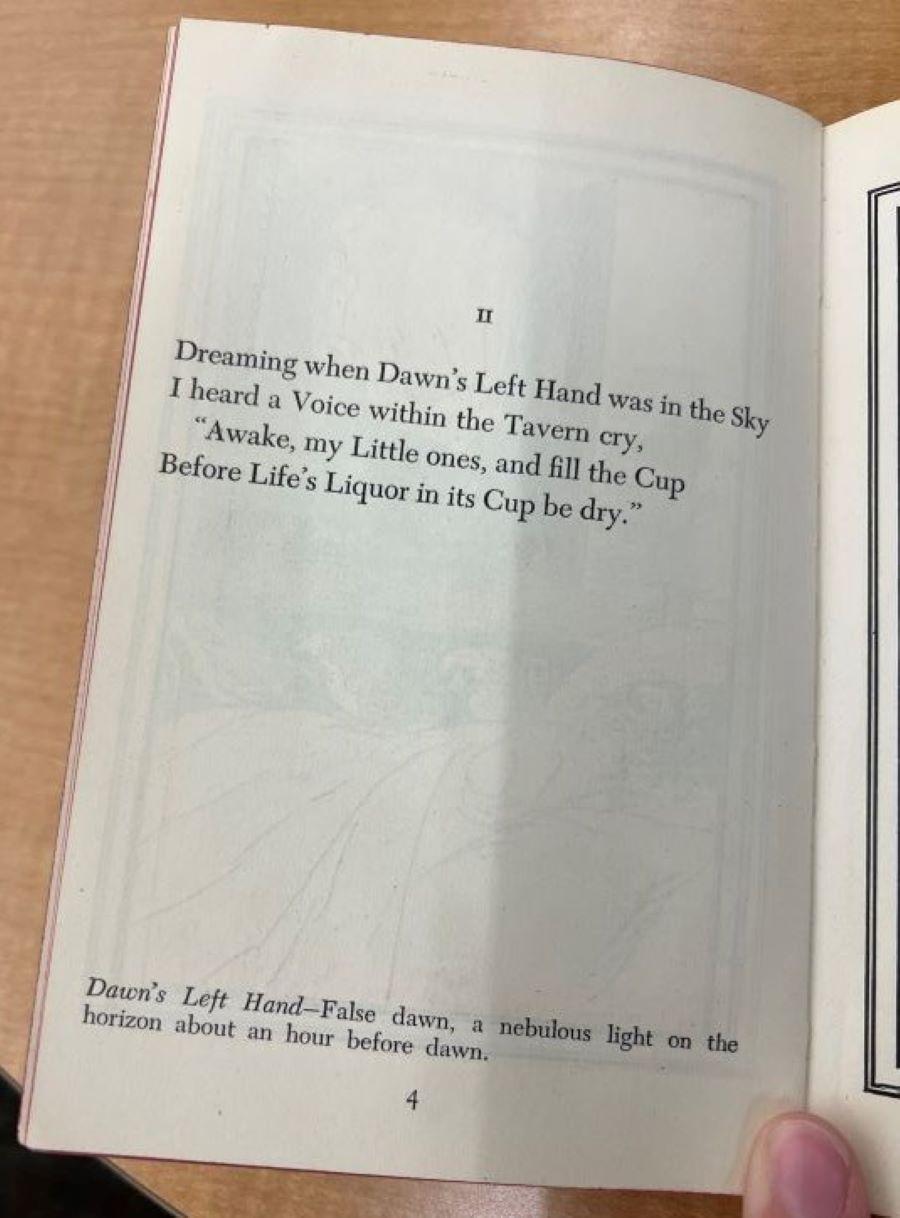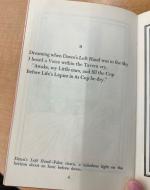Created by Brontae Sodeman on Wed, 05/10/2023 - 16:28
Description:
The stanza I chose to highlight for this exhibit is stanza II of the first translation of The Rubáiyát of Omar Khayyám along with the Gordon Ross illustration that goes with it in the 1941 Pocketbook Edition. The illustrator takes some liberties with this stanza in the way of signifiers which demonstrates how artists have freedom in the depictions of texts but still convey the same meaning. Exploring Ross's choice of depiction helps the reciever of the gift book interact and understand the plot of the text, but the art is also able to stand on it's own with the obvious signifiers Ross uses. Exploring stanza II paired with Gordon Ross's art, readers assume and understand how the text was transformed and imagined.
“Dreaming when Dawn’s Left Hand was in the Sky,” the first line of the stanza which is paired with a footnote that describes Dawn’s Left Hand as a false dawn, or the hour before dawn (Line 1 Image 1). Despite Fitzgerald’s first translation and the footnote’s clarification, Ross chooses to focus less on the appearance of the dawn and more on a rooster crowing and other signifiers of the art’s setting and time (Image 2). Ross draws two men sleeping and a candle wick running out to more directly depict the dreaming and dawn of line one (Image 2). Ross’s nuances and changes are easily understood to be the artist's direct interpretation to these lines. There's very little exploration of timing and setting with this image, the text is very easy to understand and the artist applied this directly to their rendition.
We’re unsure of which direction the tavern is facing but we can assume the sun is rising on the left, “I heard a Voice within the Tavern cry,” Ross drew one larger man awake and raising his glass in the middle of the illustration (Line 2 Image 1). Another understanding of this line is that it’s not a literal man within the tavern that is yelling, but an omnipotent God or bodiless metaphor. Ross chose to depict the voice as a larger man which is explained in the next line by, “‘Awake, my Little ones, and fill the Cup,’” (Line 3 Image 1). Again Ross went in a more literal direction by drawing the other men of the scene sleeping and smaller than the man who is talking (Image 2). The dress of these characters is also worth noting as they are wearing fezzes and robes, to exaggerate the Middle Eastern origins of FItzgerald’s first translation (Image 2). Ross exhibits a lot of freedom in the meaning of the first three lines by simply choosing setting, signifiers and details for his drawing. The imagery creates a concrete perception of the text, but readers are still able to make their own assumptions despite what Ross chose to understand about the stanza.
“‘Before Life’s Liquor in its Cup be dry,’” literally meaning drink while you’re alive, in my opinion (Line 4 Image 1). Ross details this by the barrels in the background of the imagery and by the men pouring another glass (Image 2). The setting of the image is also a tavern, which is inherently where people serve drinks. A more direct application of the line is taken by Ross in this image as there is a clear connection between the meaning and the art (Image 2). The illustrator practices varying levels of freedom with this art in relation to stanza II, and evidence of this continues throughout the 1941 Pocketbook Edition of the book. Some of Ross’s nuances and changes are to be understood as an artist's exploration next to the stanza but they can also be understood separately by signifiers that interact and mean something within society, especially in our modern era.
Copyright:
Associated Place(s)
Part of Group:
Artist:
- Gordon Ross



